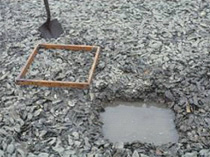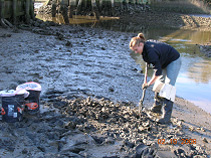Oyster density, or the number of live oysters per unit area (usually adjusted to per m2), is a common metric measured to assess reef restoration success. Density can be measured by excavating a sample of known dimensions to a specific depth (e.g., 10-15 cm) using either a quadrat or a core and then counting all the live and⁄or dead oysters (see Figure). Samples can be collected from different reef elevations including the reef crest, slope and base to better understand the spatial variation in oyster abundance. On subtidal reefs density also can be estimated using videography or calibrated dredge samples. Additional data including size frequency distributions and survival rates also can be collected from density samples.


Examples of quadrat sampled (left image) to a known depth (photo from D. Meyer and L. Coen). Excavation often is easiest using a pitchfork (right image) and carefully placing all shell and associated fauna in sturdy plastic bags lining a 20 l bucket (photo from K. Walters).







